Weed control in lettuce and other crops is a key issue this time of year. Purslane is particularly problematic and is adapted to warm conditions and can grow very rapidly especially during July and August. At times growers and PCAs are disappointed with the efficacy of Kerb on this weed. Kerb is effective in controlling purslane but it is readily leached and, if applied at planting, it can be moved below the zone of germinating weed seeds with the germination water. For instance, 6-8 hours of sprinkler water (1.5 to 2.0 inches) are commonly applied in the first germination water which can move the Kerb below the upper 0.5 inch of soil which is the zone where the weed seeds germinate; the movement of Kerb with the germination water is particularly problematic on sandy soils. Prefar does not leach and thus provides most of the purslane control when the two materials are tank mixed (Figure 1). However, Prefar does not control shepherd's purse or nightshades which can also be problematic in lettuce fields. Therefore, it would be advantageous to optimize the efficacy of Kerb to maximize the control of purslane as well as other weeds.
In the desert, the use of delayed applications of Kerb has been used for many years. Due to the large amounts of water that are applied in their hot conditions, Kerb is applied in the 2nd or 3rd germination water, approximately 3-5 days following the first germination water, just prior to the emergence of the lettuce seedlings. This technique can also be utilized in the Salinas Valley. We have looked at this technique over the years and have found it to improve the efficacy of Kerb (Figure 2). These data illustrate the loss of control of purslane by Kerb when applied before the 1st germination water, as well as the improvement in efficacy that results when applied following the 1st germination water. It also illustrates the role that Prefar plays in the control of purslane when the efficacy of Kerb is lost by leaching. It should be mentioned that the label states that the maximum amount of Kerb that can be applied through the sprinklers is 2.5 pints/A and the amount used in this trial was for experimental purposes only. Clearly there is benefit from applying the Kerb later in the 2nd or 3rd germination water, however, we observed that applying the Kerb at the end of the 1st germination water also provided improved efficacy of Kerb. Clearly, anything that helps to keep the Kerb in the top 0.5 inch of soil improves its efficacy.
Here are some details that need to be considered regarding the application of Kerb later in the germination phase of the crop: There is a need to use an injection pump and tank. We have typically used a tank with a circulating mechanism to keep the Kerb in suspension while the injection was occurring. The material needs to be injected into the mainline in a location where proper mixing can occur before it begins to flow down the laterals. The most difficult issue that growers face is the compatibility of the injection with surrounding crops. This is probably the greatest challenge and must be carefully thought through before attempting an application.
Another idea that we explored last year was the use of an additive to help retain the Kerb in the upper portion of the soil where it can be most active. However, we did not see improved efficacy in two 2018 trials (data not shown).
Many growers now are now using drip irrigation to germinate lettuce. Grower may apply the same amount of water with drip germination as with sprinklers, but the movement of the water is different which affects a surface applied material differently. With this method of germination, there are a couple of interesting dynamics that occur: 1) Kerb is not pushed too deep by this germination method and effectively reduces weed populations whether injected into the germ water (currently not a registered method of application) or sprayed on the soil surface and activated by the drip germination water (Table 1); and 2) fewer weeds emerge with drip germination than with sprinklers, regardless of the herbicide program.


